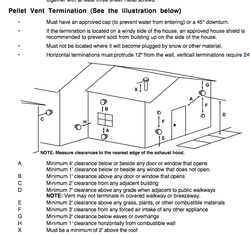Hi,
We have a freestanding Whitfield Advantage II that is about 15 years old. It was installed by just venting with a horizontal pipe about 3 feet away from the house.
According to the manual, this is up-to-code. But as all of you probably know, it means
1. The side of the garage that is nearest the pipe is covered in soot
2. The walkway between the garage and house is covered in ash
3. Every time the stove goes off, our room fills with smoke because there is no up-draft. (draught?)
We're having our house and garage resided (due to rot, not just the soot) and our contractor said he would install a vertical flue for us as part of the project if we supply the materials. (He has a pellet stove of his own).
He mentioned something about 3 feet higher than the top of the house.
So....
Any advice you can give me would be helpful.
What do I need? I've been reading about T junctions and pellet stove (not wood stove) end caps.
Do I just buy all this stuff at Home Depot or do I need to go to a stove shop? Or online somewhere?
What material should this be?
Anything else I need to know? I have 0 knowledge in this area. Other than what happens if you don't vent vertically.
Thanks a lot,
Susie
We have a freestanding Whitfield Advantage II that is about 15 years old. It was installed by just venting with a horizontal pipe about 3 feet away from the house.
According to the manual, this is up-to-code. But as all of you probably know, it means
1. The side of the garage that is nearest the pipe is covered in soot
2. The walkway between the garage and house is covered in ash
3. Every time the stove goes off, our room fills with smoke because there is no up-draft. (draught?)
We're having our house and garage resided (due to rot, not just the soot) and our contractor said he would install a vertical flue for us as part of the project if we supply the materials. (He has a pellet stove of his own).
He mentioned something about 3 feet higher than the top of the house.
So....
Any advice you can give me would be helpful.
What do I need? I've been reading about T junctions and pellet stove (not wood stove) end caps.
Do I just buy all this stuff at Home Depot or do I need to go to a stove shop? Or online somewhere?
What material should this be?
Anything else I need to know? I have 0 knowledge in this area. Other than what happens if you don't vent vertically.
Thanks a lot,
Susie


